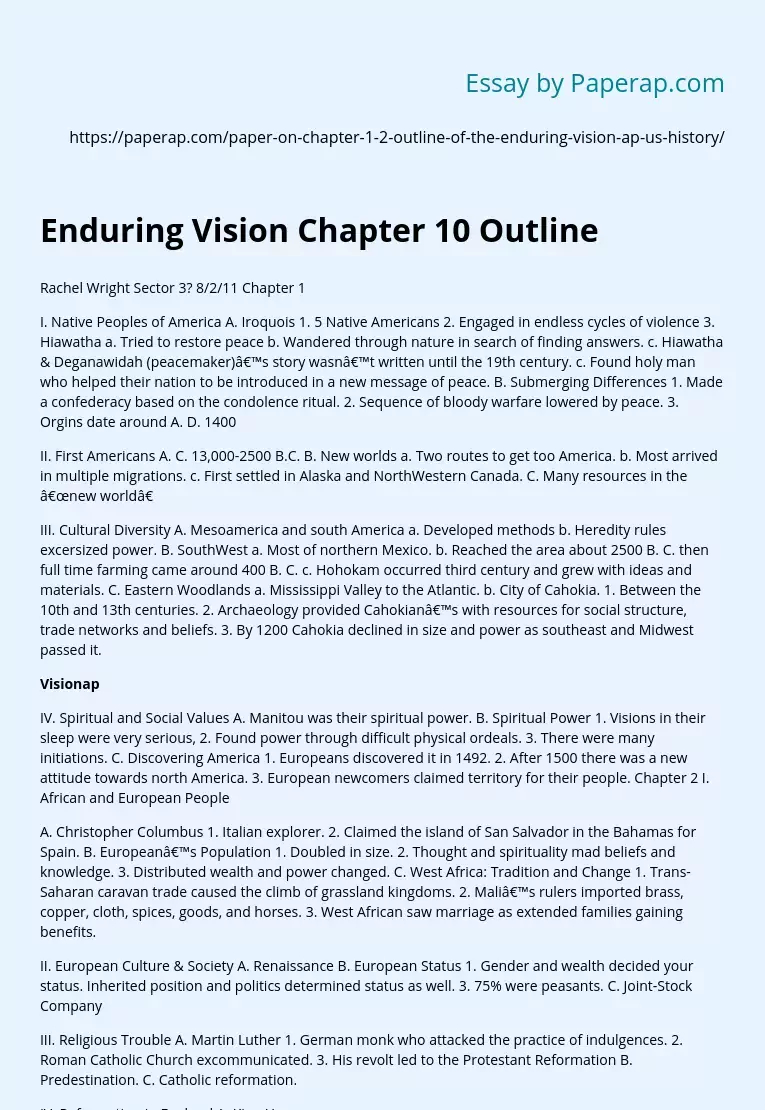Enduring Vision Chapter 10 Outline
Rachel Wright Sector 3? 8/2/11 Chapter 1
I. Native Peoples of America A. Iroquois 1. 5 Native Americans 2. Engaged in endless cycles of violence 3. Hiawatha a. Tried to restore peace b. Wandered through nature in search of finding answers. c. Hiawatha & Deganawidah (peacemaker)’s story wasn’t written until the 19th century. c. Found holy man who helped their nation to be introduced in a new message of peace. B. Submerging Differences 1. Made a confederacy based on the condolence ritual. 2. Sequence of bloody warfare lowered by peace.
3. Orgins date around A. D. 1400
II. First Americans A. C. 13,000-2500 B.C. B. New worlds a. Two routes to get too America. b. Most arrived in multiple migrations. c. First settled in Alaska and NorthWestern Canada. C. Many resources in the “new world”
III. Cultural Diversity A. Mesoamerica and south America a. Developed methods b. Heredity rules excersized power. B. SouthWest a. Most of northern Mexico. b. Reached the area about 2500 B. C. then full time farming came around 400 B.
C. c. Hohokam occurred third century and grew with ideas and materials. C. Eastern Woodlands a. Mississippi Valley to the Atlantic. b. City of Cahokia. 1. Between the 10th and 13th centuries. 2. Archaeology provided Cahokian’s with resources for social structure, trade networks and beliefs. 3. By 1200 Cahokia declined in size and power as southeast and Midwest passed it.
Visionap
IV. Spiritual and Social Values A. Manitou was their spiritual power. B. Spiritual Power 1. Visions in their sleep were very serious, 2. Found power through difficult physical ordeals. 3. There were many initiations.
C. Discovering America 1. Europeans discovered it in 1492. 2. After 1500 there was a new attitude towards north America. 3. European newcomers claimed territory for their people. Chapter 2 I. African and European People
A. Christopher Columbus 1. Italian explorer. 2. Claimed the island of San Salvador in the Bahamas for Spain. B. European’s Population 1. Doubled in size. 2. Thought and spirituality mad beliefs and knowledge. 3. Distributed wealth and power changed. C. West Africa: Tradition and Change 1. Trans-Saharan caravan trade caused the climb of grassland kingdoms. 2. Mali’s rulers imported brass, copper, cloth, spices, goods, and horses. 3. West African saw marriage as extended families gaining benefits.
II. European Culture & Society A. Renaissance B. European Status 1. Gender and wealth decided your status. Inherited position and politics determined status as well. 3. 75% were peasants. C. Joint-Stock Company
III. Religious Trouble A. Martin Luther 1. German monk who attacked the practice of indulgences. 2. Roman Catholic Church excommunicated. 3. His revolt led to the Protestant Reformation B. Predestination. C. Catholic reformation.
IV. Reformation in England A. King Henry
VIII 1. Persuaded Parliament to pass a series of acts. 2. Occurred in 1533-1534 3. Supreme head of the Church of England. B. Europe and the Atlantic World 1. Europeans introduce Christianity to savages and pagans. 2.
Transatlantic slave trade. 3. Colonization of the Americas. C. Puritanism to the middle ranks. V. New Life A. New England 1. 1620 families were sent over in the Mayflower. 2. Plymouth was established by English immigrants. 3. Squanto helped causing Thanksgiving. B. America 1. Sail westward across the Atlantic rather than around Africa. 2. America was named after Amerigo Vespucci. 3. Tordesillas drew a line in the mid-Atlantic. C. Slavery and Racism 1. Portuguese traded weapons with Africans. 2. Europeans justified enslaving blacks as their Christian duty. 3. Many Africans were enslaved because of indebtedness.
Enduring Vision Chapter 10 Outline. (2019, Dec 05). Retrieved from https://paperap.com/paper-on-chapter-1-2-outline-of-the-enduring-vision-ap-us-history/

